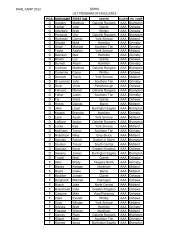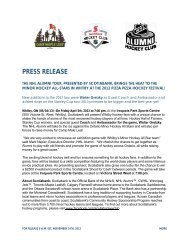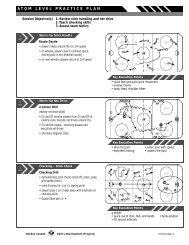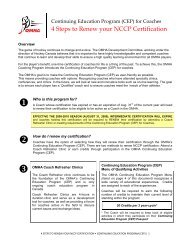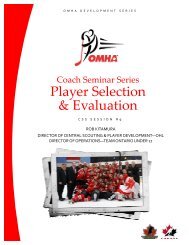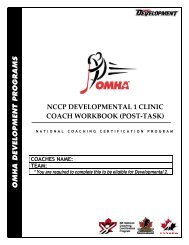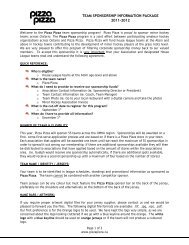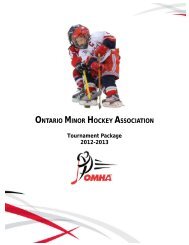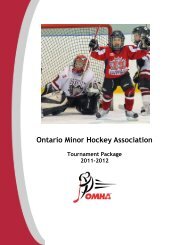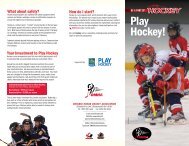Player Evaluation & Selection - Ontario Minor Hockey Association
Player Evaluation & Selection - Ontario Minor Hockey Association
Player Evaluation & Selection - Ontario Minor Hockey Association
You also want an ePaper? Increase the reach of your titles
YUMPU automatically turns print PDFs into web optimized ePapers that Google loves.
APPENDICES<br />
PLAYER EVALUATION AND SELECTION<br />
One question that will often be raised during the evaluation process is - "When should a player declare<br />
the position that they want to play?" There is a tremendous amount of research that supports the belief<br />
that a child should not specialize early - in fact the longer an athlete avoids specialization (especially in an<br />
open ended dynamic game like hockey) potentially the greater skill they will gain to play all positions.<br />
In "The Parents' Guide to <strong>Minor</strong> <strong>Hockey</strong> a current AHL player claims:<br />
"I only ever played defence, and then one day my coach put me on right wing…It was so hard at first to<br />
make the transition. My whole game was thrown off. There I was in the middle of everything and I just<br />
couldn't read the ice as well…I started to watch the forwards on video, on ice and I asked the coaches<br />
and forwards lots of questions…I can't believe that a few years later I am still playing forward…I know<br />
now how important it is to be able to play different positions when the coach needs you to…I just wish I<br />
had been more versatile when I was younger."<br />
From the book "<strong>Hockey</strong> Agility" by Dr.'s Yasha and Elena Smushkin; "Skills and overall athletic<br />
conditioning in young hockey players which would normally provide for the entertainment aspect of the<br />
game are absent. To compensate for this, coaches use other tactics. One of these is the so-called<br />
position approach that dominates the game.<br />
According to this the child is required to strictly play his own position. If he happens to take control of the<br />
puck, he must either shoot or pass it to another member of the team as quickly as possible. The use of<br />
this position approach in the game between children who lack even the basic skills results in the sadlyfamous<br />
"bump in, bump out" tactics; right after getting the puck, the child flings it, often in no particular<br />
direction. This leaves the impression that he is afraid of the puck and wants to get rid of it as fast as<br />
possible. Most of the time, the kids are not playing with the puck, but are chasing it".<br />
With this type of information in mind it is highly recommended that positional specialization for<br />
players does not exist until Peewee at the earliest (Atom for Goaltenders). <strong>Player</strong>s trying out at<br />
the Atom level and below should not pre-select a position. The selection of players at these levels<br />
should be on their overall hockey skills and ability to "play" the game.<br />
- 63 -<br />
© <strong>Hockey</strong> Canada



